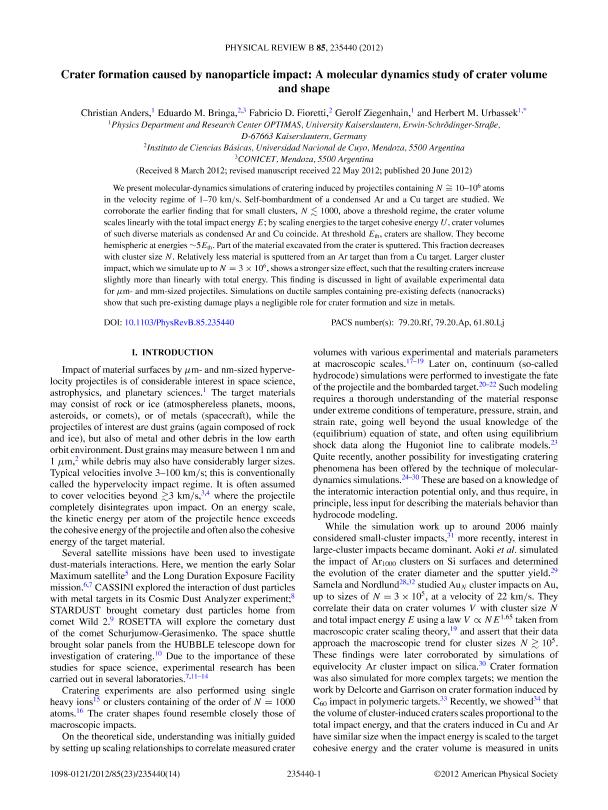Artículo
Crater formation caused by nanoparticle impact: A molecular dynamics study of crater volume and shape
Anders, Christian; Bringa, Eduardo Marcial ; Fioretti, Fabricio D.; Ziegenhain, Gerolf; Urbassek, Herbert M.
; Fioretti, Fabricio D.; Ziegenhain, Gerolf; Urbassek, Herbert M.
 ; Fioretti, Fabricio D.; Ziegenhain, Gerolf; Urbassek, Herbert M.
; Fioretti, Fabricio D.; Ziegenhain, Gerolf; Urbassek, Herbert M.
Fecha de publicación:
20/06/2012
Editorial:
American Physical Society
Revista:
Physical Review B: Condensed Matter And Materials Physics
ISSN:
1098-0121
Idioma:
Inglés
Tipo de recurso:
Artículo publicado
Clasificación temática:
Resumen
We present molecular-dynamics simulations of cratering induced by projectiles containing N ∼= 10–106 atoms in the velocity regime of 1–70 km/s. Self-bombardment of a condensed Ar and a Cu target are studied. We corroborate the earlier finding that for small clusters, N 1000, above a threshold regime, the crater volume scales linearly with the total impact energy E; by scaling energies to the target cohesive energy U, crater volumes of such diverse materials as condensed Ar and Cu coincide. At threshold Eth, craters are shallow. They become hemispheric at energies ∼5Eth. Part of the material excavated from the crater is sputtered. This fraction decreases with cluster size N. Relatively less material is sputtered from an Ar target than from a Cu target. Larger cluster impact, which we simulate up to N = 3 × 106, shows a stronger size effect, such that the resulting craters increase slightly more than linearly with total energy. This finding is discussed in light of available experimental data for μm- and mm-sized projectiles. Simulations on ductile samples containing pre-existing defects (nanocracks) show that such pre-existing damage plays a negligible role for crater formation and size in metals.
Palabras clave:
Nanocracks
,
Crater Formation
Archivos asociados
Licencia
Identificadores
Colecciones
Articulos(CCT - MENDOZA)
Articulos de CTRO.CIENTIFICO TECNOL.CONICET - MENDOZA
Articulos de CTRO.CIENTIFICO TECNOL.CONICET - MENDOZA
Citación
Anders, Christian; Bringa, Eduardo Marcial; Fioretti, Fabricio D.; Ziegenhain, Gerolf; Urbassek, Herbert M.; Crater formation caused by nanoparticle impact: A molecular dynamics study of crater volume and shape; American Physical Society; Physical Review B: Condensed Matter And Materials Physics; 85; 23; 20-6-2012; 1-14; 235440
Compartir
Altmétricas



